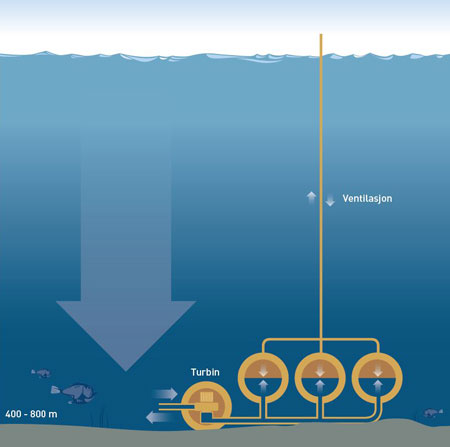| May 15, 2013 |
A novel concept to store electricity at the bottom of the sea
|
|
(Nanowerk News) The idea of an underwater pumped hydroelectric power plant may sound like Jules Verne fiction, but then it was hatched by a German engineer who has spent much of his professional life working in aerospace technology.
|
|
“Imagine opening a hatch in a submarine under water. The water will flow into the submarine with enormous force. It is precisely this energy potential we want to utilize,” explains Rainer Schramm, inventor and founder of the company Subhydro AS to Gemini.no. “Many people have launched the idea of storing energy by exploiting the pressure at the seabed, but we are the first in the world to apply a specific patent-pending technology to make this possible,” he adds.
He has joined forces with SINTEF in order to realize the concept.
|
 |
| To use the water pressure at the sea bed in practice, the mechanical energy is converted by a reversible pump turbine, as in a normal pumped storage hydroelectric plant. (Illustration: Knut Gangåssæter/Doghouse)
|
|
Turbine converts energy
|
|
“SINTEF has experts in the fields of energy generation, materials technology and not least offshore and deep-water technology, which means we have all the expertise we need in one place,” says the German inventor.
|
|
To use the water pressure at the sea bed in practice, the mechanical energy is converted by a reversible pump turbine, as in a normal pumped storage hydroelectric plant.
|
|
“A pumped storage power plant is a hydroelectric plant which can be “charged” up again by pumping the water back to the upper reservoir once it has passed through a turbine. This type of power plant is used as a “battery”, when connected to the power grid,” the inventor explains.
|
|
In this pumped storage power plant turbine will be connected to a tank on the seabed at a depth of 400-800 metres. The turbine is fitted with a valve, and when this is opened, water flows in and starts turning the turbine. The turbine drives a generator to produce electricity. One can connect as many tanks as one wishes. In other words, it is the number of water tanks that decides how long the plant can generate electricity, before the energy storage capacity is exhausted.
|
|
High degree of storage efficiency
|
|
“When the water tanks are full, the water must be removed from the tanks,” Schramm explains.
This is achieved by running the turbine in reverse, so that it functions as a pump. The process consumes energy from the power grid, just as when one charges an ordinary battery. Although a bit more energy is used to empty the water tanks than can be recovered from flooding them, the degree of efficiency of this type of power plant is just as high as that of a conventional, onshore plant. According to Schramm, calculations indicate an electric storage efficiency of approximately 80 per cent round-trip.
|
|
Another advantage of the system is that equipment can be scaled according to users’ requirements, both as regards the turbine size and the number of water tanks. A plant of normal size will produce roughly 300 megawatts for a period of 7-8 hours. This is enough energy to supply just over 200,000 British households with electricity for the same time.
|
|
“We envisage that this type of storage plant will function well in conjunction with, for example, wind farms. At strong wind conditions, excess electricity is sent subsea to pump water out of the storage tanks. In periods with little wind, energy can be obtained from this underwater plant instead. The same applies to solar generation: the pumped storage power station can contribute to constant electricity production at night time when there is no sunshine to run a solar power plant,” says Rainer Schramm.
|
|
The deeper the better
|
|
In addition to the number of tanks, the sea depth also determines the effectiveness of the plant: the deeper the equipment is located, the greater is the pressure difference between the sea surface and the seabed, and the more energy is stored in a single tank.
|
|
“This is part of the reason why we want to try out the technology in Norway,” says Rainer Schramm. In his native country Germany the sea is too shallow for the system to be profitable, but there are many parts of the world where great water depths are located close inshore, such as the marine areas around Italy, Portugal and Spain, as well as North and South America.
|
|
Advanced concrete technology
|
|
One of the challenges faced by the SINTEF research scientists is to develop a type of concrete which can be used to cast the water tanks which are placed on the seabed.
|
|
Tor Arne Martius-Hammer at SINTEF Building and Infrastructure is an expert on strong, light concrete types.
|
|
“The challenge is to find the optimal balance between strength and cost. If we achieve the goal of creating a concrete which will withstand at least 5 times as high loading as ordinary concrete, we can reduce the wall thickness by 75 per cent. This is a critical factor. We need to reach production and installation costs which make storage of energy economical in relation to the price of electrical energy,” Martius-Hammer explains.
|
|
One of the solutions SINTEF will work on is reinforcing the concrete with thin steel fibres instead of the normal steel rebar. This will result in a significant simplification of the production process. Concrete is in existence at present which can be used, but our job is to develop a cheaper alternative,” says Martius-Hammer.
|

